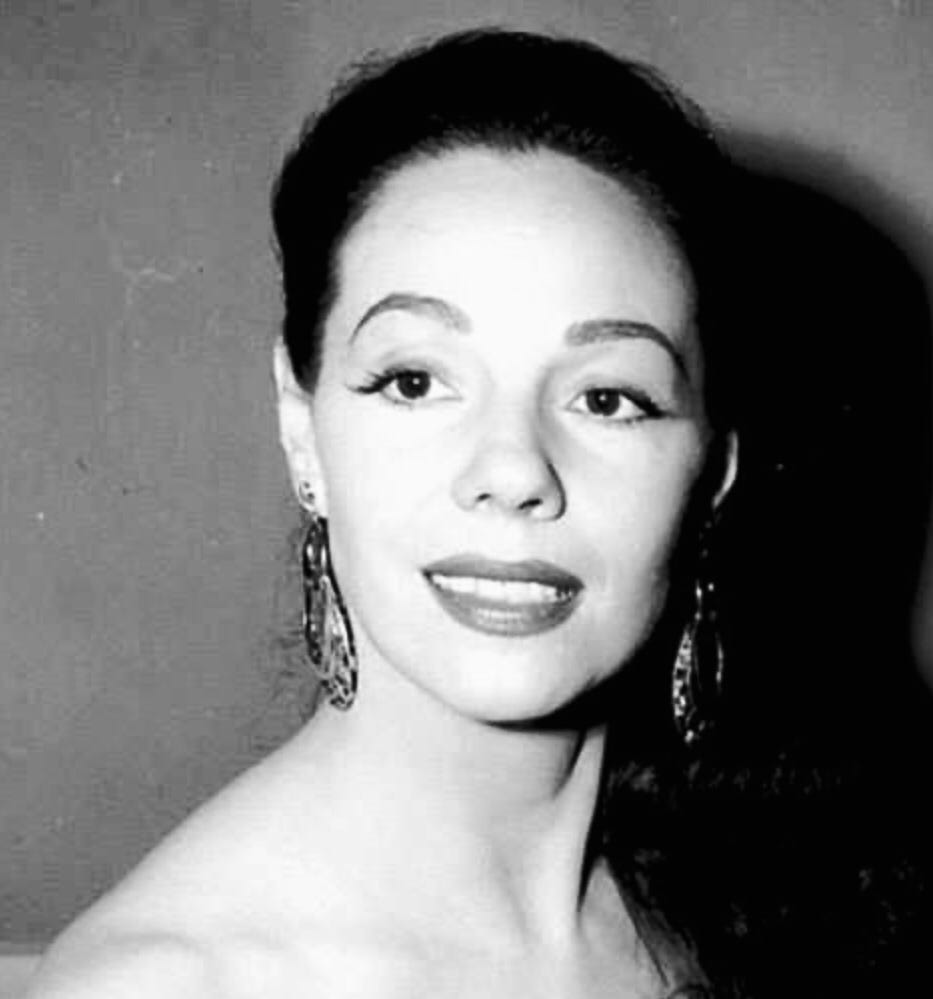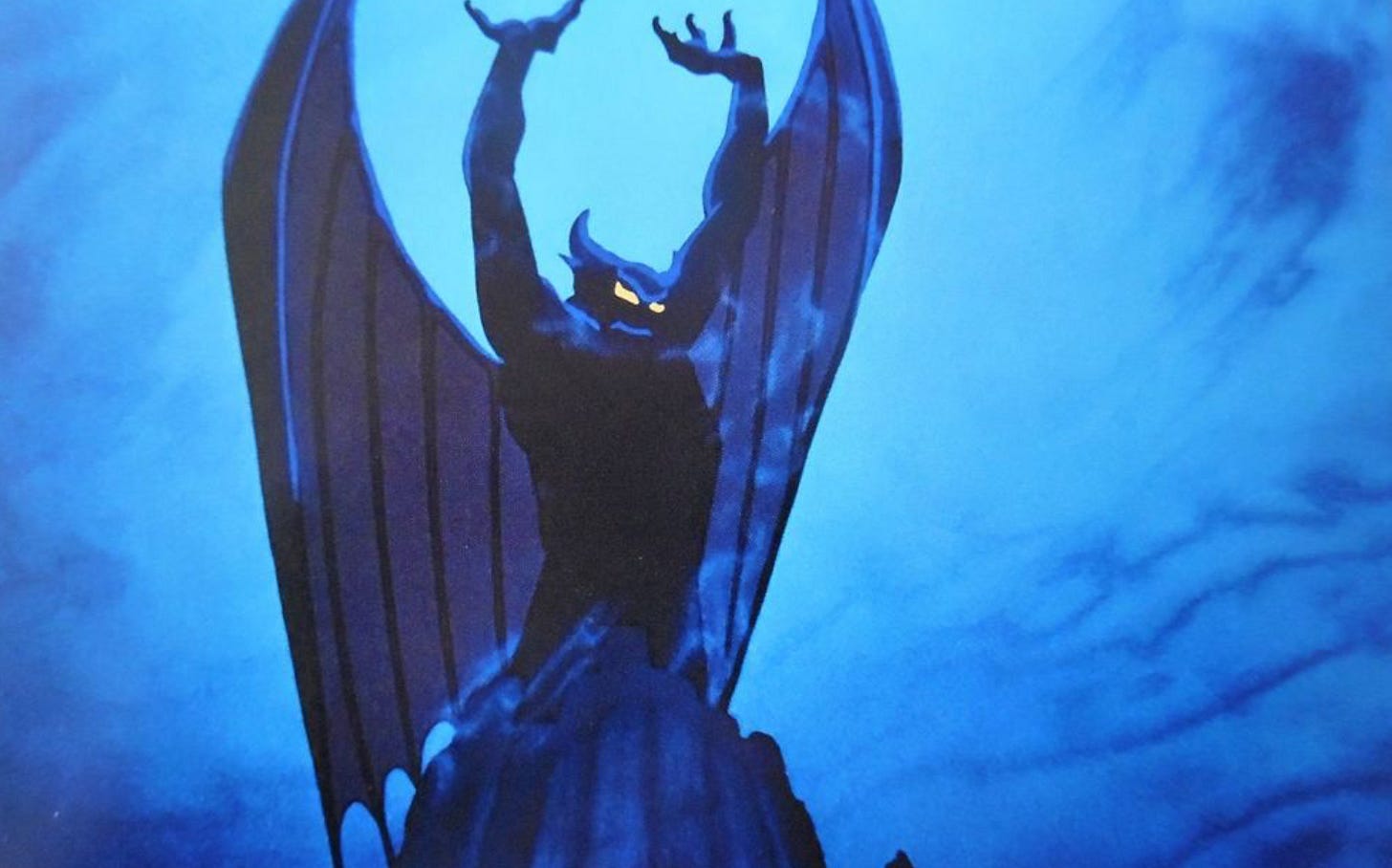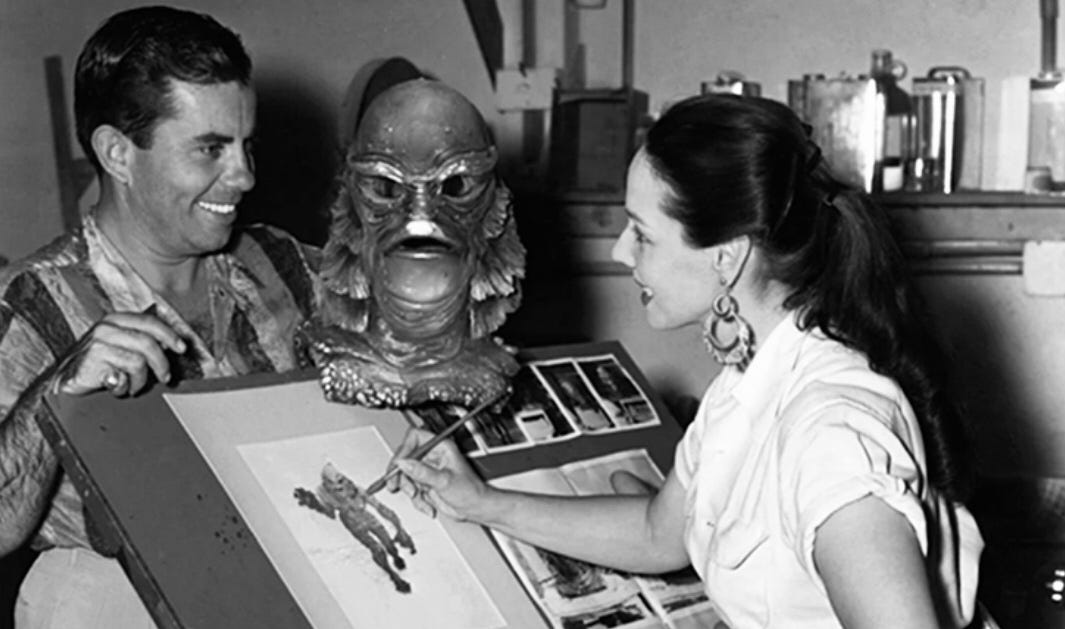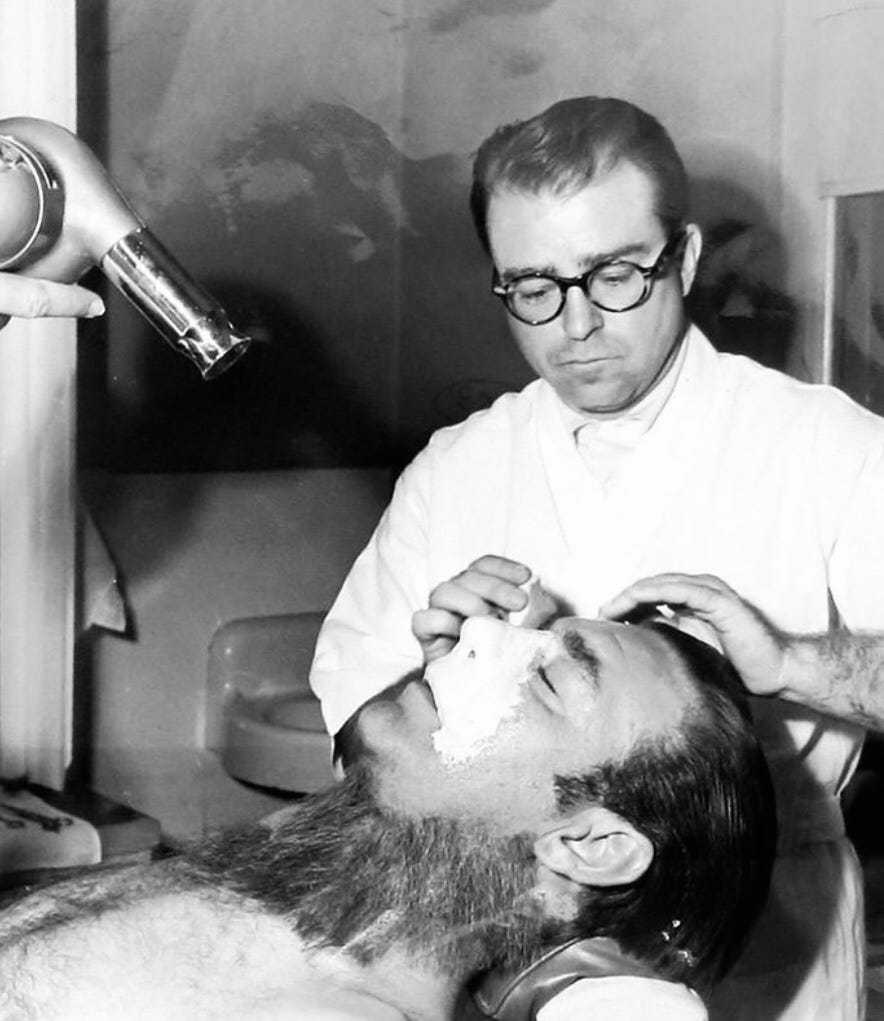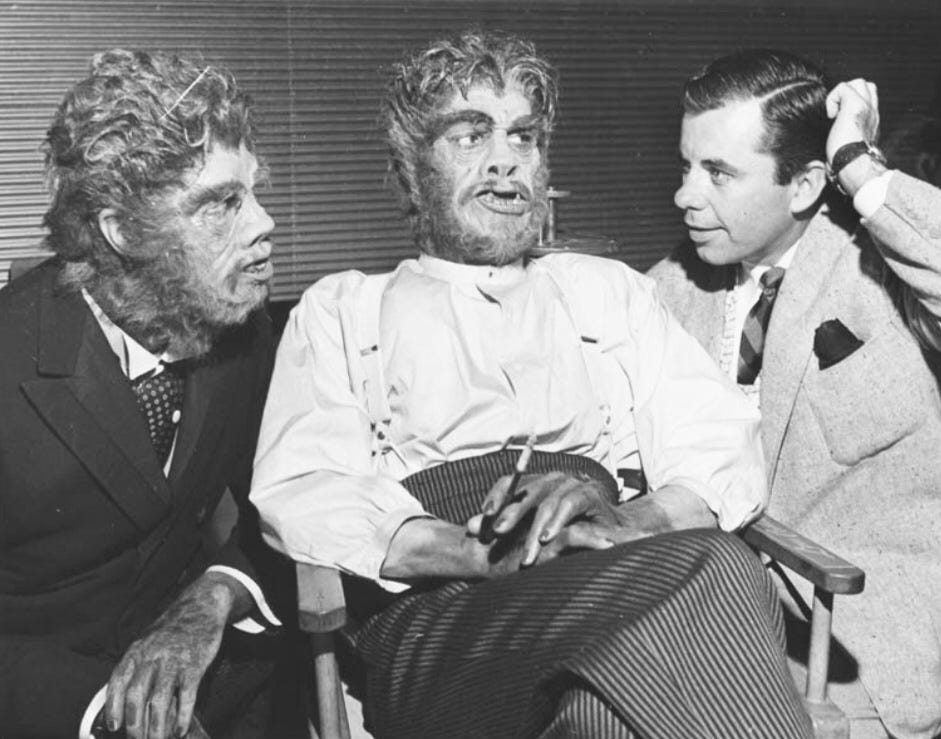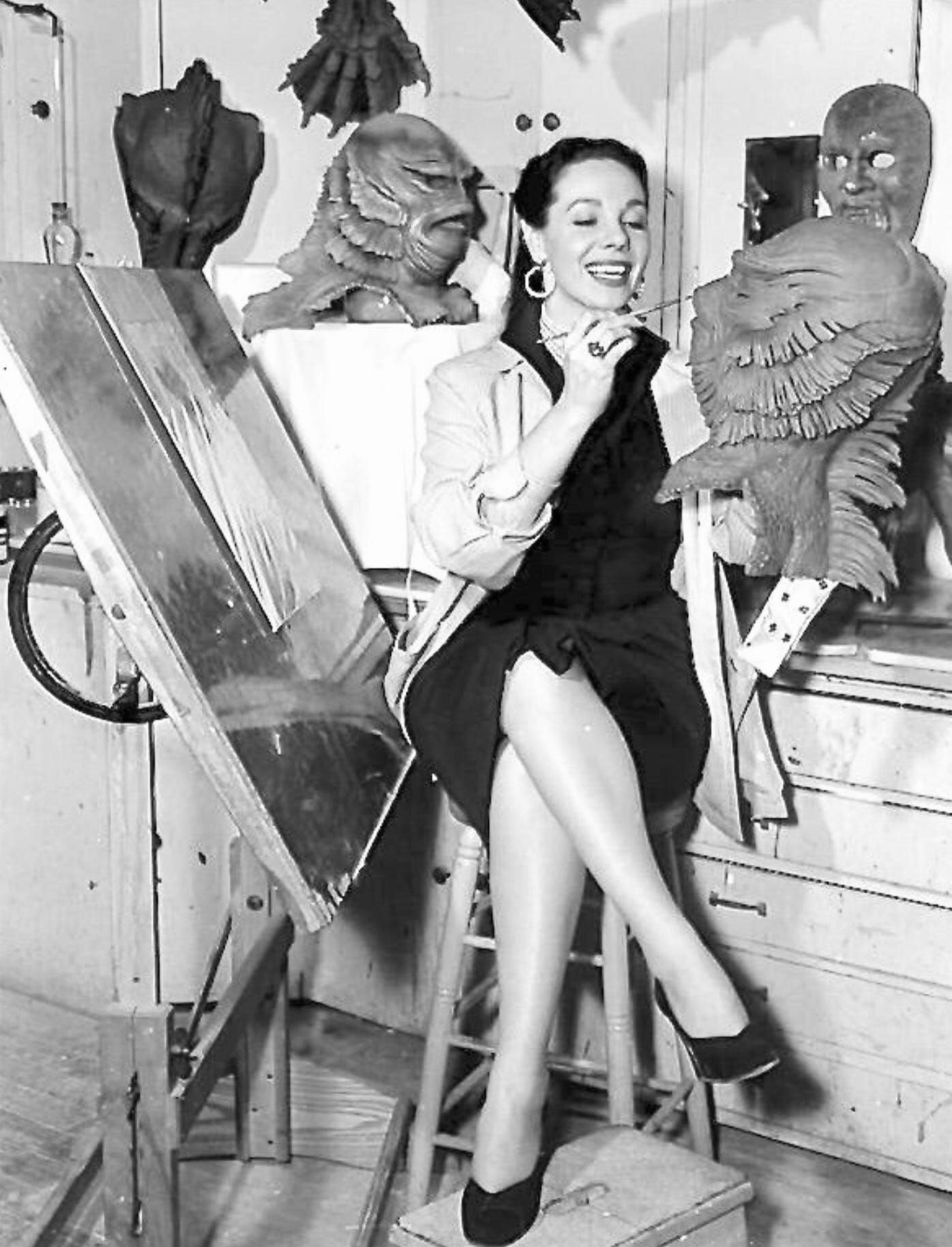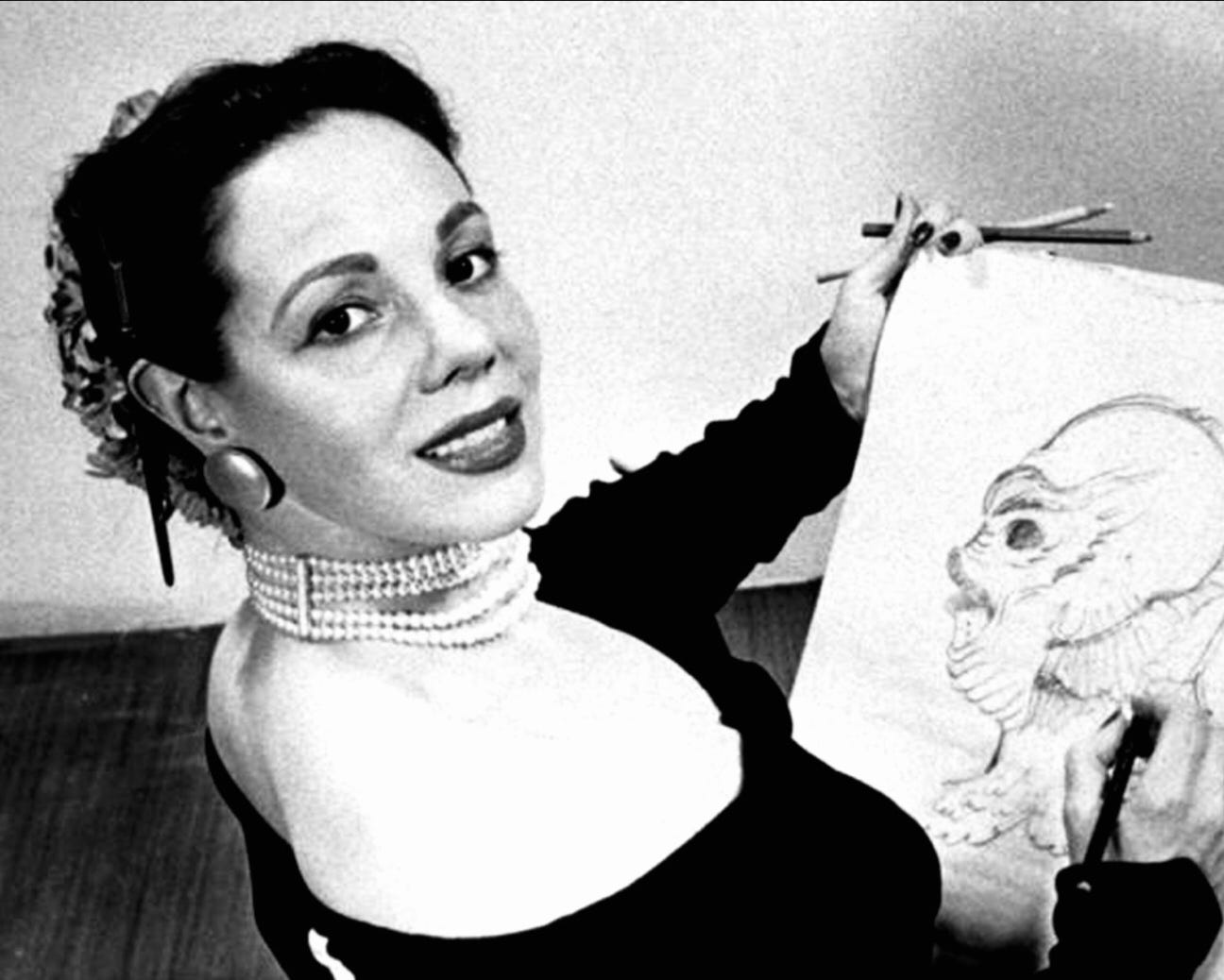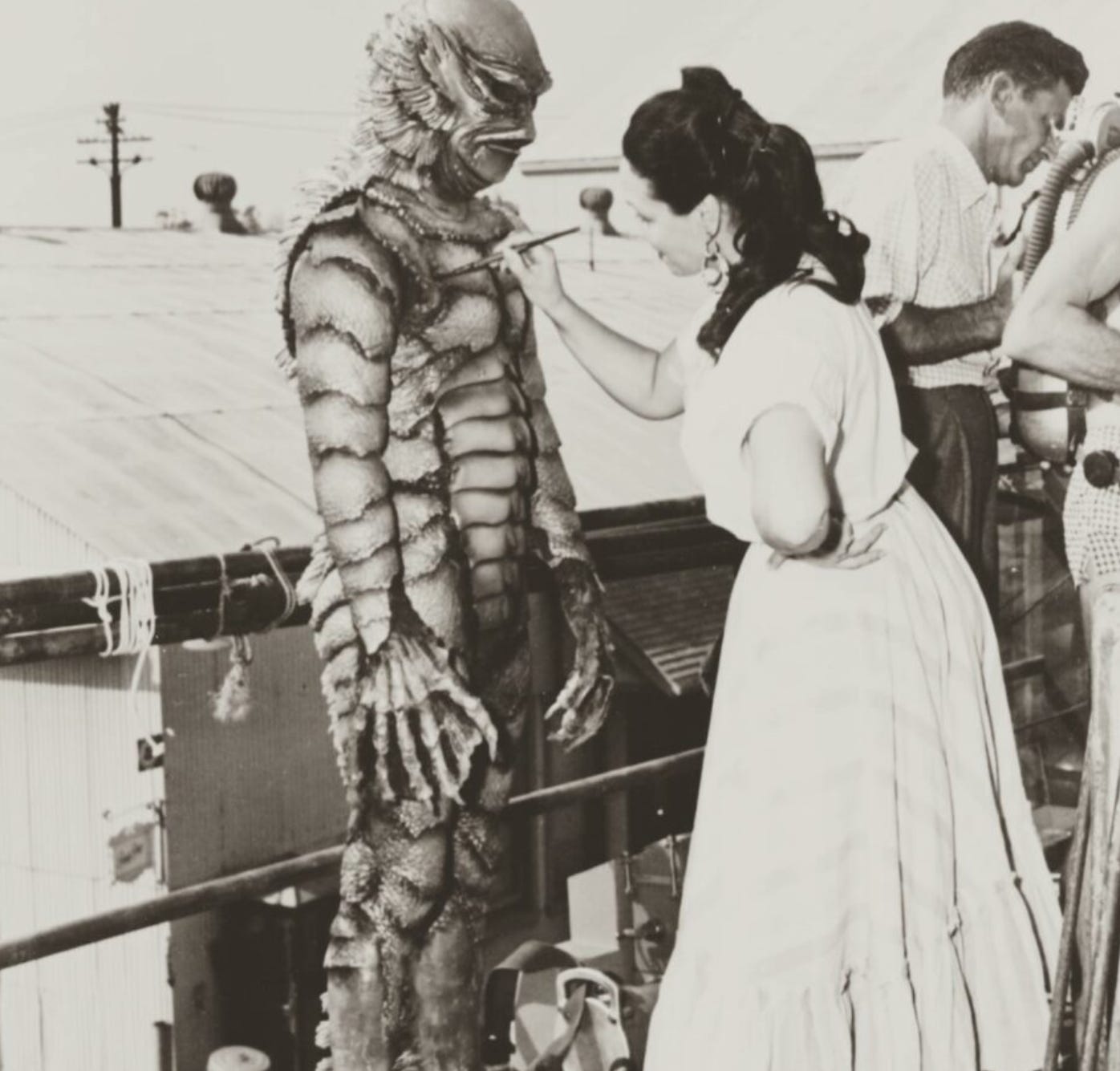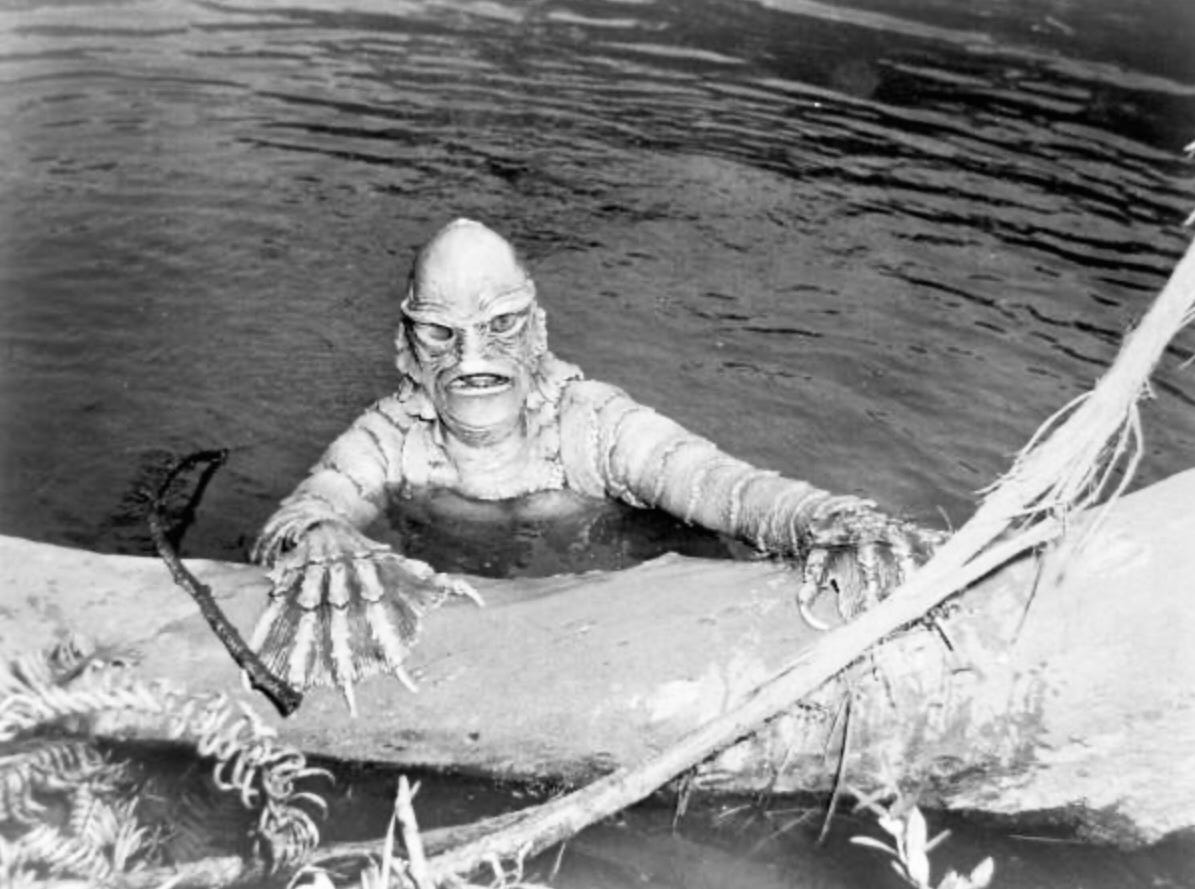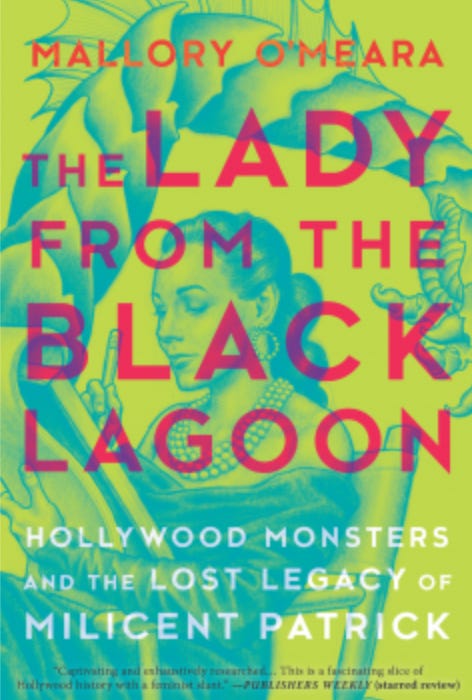Classic Horror Behind the Scenes: Milicent Patrick, the Lady Who Designed the Gill Man for CREATURE FROM THE BLACK LAGOON
For years, Monster Kids were led to believe that Universal’s makeup chief Bud Westmore was responsible for the iconic creature…which is exactly what Westmore wanted.
By Bill Fleck, author of the Rondo-nominated book CHANEY’S BABY, available here.
Check out other articles on my Rondo-nominated website by clicking here.
Did you know? Two-time Rondo-Award winning filmmaker Thomas Hamilton is in the process of making THE CHANEYS: HOLLYWOOD’S HORROR DYNASTY, which is inspired by my book, CHANEY’S BABY. (I’m also a producer on the film.) If you’d like to support the project, click here and see what’s going on. Thanks!
Thanks to everyone who voted for this website once again for a RONDO HATTON CLASSIC HORROR AWARD (Best Website). We didn’t win, but I feel like we’ll be back next year!
NOTE: Much of the information in this column comes from Mallory O’Meara’s well-researched biography of Milicent Patrick, entitled THE LADY FROM THE BLACK LAGOON (2019), available here. If you enjoy this column, I encourage you to seek out O’Meara’s book.
Milicent Patrick—who will one day design the Gill Man for CREATURE FROM THE BLACK LAGOON—comes into the world on November 11, 1915 as Mildred Elisabeth Fulvia Rossi. She’s the proverbial middle child.
Her mom, Elise Bill, is the daughter of German immigrants. She’s a San Francisco society girl and a talented artist who loves the theater. She is also frequently described as “unhappy.” According to Mallory O’Meara, Patrick’s biographer, “This unhappiness and frustration was passed down to Milicent, along with her love of art in all forms.”
Part of Elise’s unhappiness is no doubt due to her husband, Camille Rossi. Born in Naples, Italy, Camille is a structural engineer who tells everyone that he, too, had been born in San Francisco. Ambitious but ruthless, he’s wildly successful, yet rules both his business and home with an iron fist. And he takes no lip from women.
“[I]t was Camille who would ultimately be the force that shaped Milicent’s life,” O’Meara concludes.
[Above: Milicent Patrick, the artist who designed the Gill Man for CREATURE FROM THE BLACK LAGOON (1954).]
In 1921, Camille takes on an amazing job with builder Julia Morgan. The project? Constructing Hearst Castle in San Simeon. The Rossi’s move to San Simeon, and over time, Millicent Hearst—wife of newspaper magnate William Randolph Hearst—takes a shine to little Mildred. Later in life, Mildred will change her name to Milicent in honor of her mentor.
Sadly, by 1932, the growing bad blood between Morgan and Camille forces Hearst to fire Rossi. The family leaves the still-unfinished castle grounds and relocates to Glendale. Milicent—constantly churning out artwork—attends the Chouniard Art Institute on scholarship. Many animators at Walt Disney Studios had previously attended the institute, and O’Meara notes that “a pipeline formed between Chouniard and Disney.”
In 1938, Walt Disney himself gets a good look at Milicent’s exquisite work. Shortly thereafter, she’s offered a job.
The only spot available to her at the time is with the “all-female ink and paint department.” But by 1940, Milicent joins Animation and Effects as one of the first female animators. Her best-known work at Disney involves the “Night on Bald Mountain” segment in FANTASIA (1940)—Milicent is among those who bring Chernabog, the famous demon, to life. She also has a hand in DUMBO (1941), and appears briefly on screen as an artist in THE RELUCTANT DRAGON (1941).
[Above: The demon Chernabog in Walt Disney’s FANTASIA (1940). Milicent Patrick had a hand in bringing him to life.]
In May of 1941, two-hundred-plus Disney staffers—seeking to make the studio a union shop—go out on strike. Milicent, always averse to conflict, hangs back. But the man she’s secretly dating—the animator and very-much married Paul Fitzpatrick—joins the strike. After five teeth-gnashing weeks, Walt Disney finally agrees to the employees’ demands and the strike ends. But going union forces a great deal of restructuring, and layoffs are unavoidable.
Milicent—suffering from crippling migraines—leaves Disney on September 12, 1941. Paul Fitzpatrick leaves the same day. Whether this is planned or just a coincidence is not known.
What we do know is that the soon-to-be 26-year-old Milicent has grown into a 5’4” beauty, with flowing black hair. As such, she begins modeling.
This causes major conflict with Camille, her controlling father. In his worldview, no honest woman puts her body on display!
Things get immeasurably worse when Paul’s wife—pregnant with their first child—discovers his affair, and inexplicably goes to none other than Camille in the hopes that he can convince Milicent to let her man go.
Milicent and Paul aren’t having it. Sadly, Paul’s wife commits suicide as a result. When Milicent and Paul marry, Milicent’s family—deciding that she’s evil—completely cuts her off. Milicent will make up stories obscuring her background in reaction to this for years to come; she will eventually claim that she herself was born in Italy to an entitled family.
But none of her stories will ever assuage the fear that her family might be right…
[Above: Being estranged from her family—and secretly fearing that they might have been right in cutting her off—Patrick often made up stories regarding her background. In this one, she claims to have been born a Baroness in Italy.]
Meanwhile, her marriage to Paul fails after only two years. Things look gloomy.
Then, one day in 1947, Milicent’s luck changes.
Now known as Mil Patrick, Milicent has just finished a modeling job at the Ambassador Hotel in Los Angeles. She’s outside patiently waiting for the bus when William Hawks walks up to her.
“I want you for the pictures,” he says.
Hawks—brother of director/producer Howard Hawks, and a noted agent in his own right—has just recently started producing movies himself. Intrigued, Milicent agrees, and begins getting extra work in films. She also enthusiastically continues with her drawings.
Meanwhile, events are taking place that will shape Milicent’s future…
Friday, February 28, 1947. This will not be a good day for Jack P. Pierce, Universal-International’s head of makeup. According to Christopher Lock—Pierce’s most recent biographer—Pierce is ordered to the executive offices that afternoon where he meets with a powerful studio suit.
“We’ve hired Bud Westmore to head up the makeup department,” the exec says. “Your services are no longer required.” [1]
Pierce—no shrinking violet—immediately flares up in anger.
“The quality of makeup will suffer in your future productions,” he fires back.
“So the makeup won’t be perfect,” the exec yawns. “People will still buy tickets, and that’s all that counts in this business.”
[Above: Bud Westmore with Patrick. Westmore was hired to replace makeup legend Jack P. Pierce. Universal executives were thrilled to get the prized Westmore name on their pictures.]
Pierce is about two months shy of 62. [2] He’s feisty, obstinate, and arrogant—“a miserable old bastard,” according to stuntman Gil Perkins. But he’s also the brilliant creator of the now-classic Universal makeups for Frankenstein’s Monster, the Mummy, and the Wolf Man…among many others.
And now, he’s unemployed.
As to his replacement?
Hamilton Adolph “Bud” Westmore is born in New Orleans on January 13, 1918. [3] He’s one of nineteen children born to makeup artist George Westmore and his wife, Ada Savage. [4] George is a British hairdresser who has made his way to L.A. In 1917, he convinces the Selig Polyscope film company that they need a hair and makeup department—a novel idea, given that actors in those days are expected to do these things for themselves.
Selig Polyscope folds in 1918, but George is established nonetheless. His specialty is wigs, especially the signature sausage curls favored by Mary Pickford and Shirley Temple. George makes these by clipping the hair off of willing prostitutes at Big Suzy’s French Whorehouse in Beverly Hills. George charges the stars big bucks for these, but pays the prostitutes back by applying their beauty makeup for free.
George’s sons inherit his talent for shaping and/or changing faces. Monte Westmore, for example, works with Rudolph Valentino for six years, supervises the makeup on MUTINY ON THE BOUNTY (1935), and caps it off with back-to-back Best Picture-winners GONE WITH THE WIND (1939) and REBECCA (1940). [5]
Perc (short for Percival) lands at Warner Brothers, where he’ll eventually supervise the makeup for classics like CASABLANCA (1942), THE TREASURE OF THE SIERRA MADRE (1948), and WHITE HEAT (1949). Monster Kids probably appreciate him most for turning Lionel Atwill into a horrendously burned villain that makes “Frankenstein look like a lily” in MYSTERY OF THE WAX MUSEUM (1933).
Ern Westmore, Perc’s twin, also lands at Warner Brothers, though his drinking problem ensures a revolving-door relationship with the studio. However, along with Perc, Ern is instrumental in founding the House of Westmore makeup studio on Sunset Boulevard in 1935, which caters to some of the biggest names in the industry, including Carole Lombard, Kay Francis, and Marlene Dietrich. [6] Later, Ern will host TV’s THE ERN WESTMORE HOLLYWOOD GLAMOUR SHOW.
Wally Westmore, meanwhile, is over at Paramount, where he’s responsible for Frederic March’s simian look in DR. JEKYLL AND MR. HYDE (1931), as well as the Manimals in the legendary ISLAND OF LOST SOULS (1933).
Youngest brother Frank apprentices under Wally at Paramount, then goes off on his own, working on films such as THE TEN COMMANDMENTS (1956) and THE TOWERING INFERNO (1974), plus TV staples like THE MUNSTERS (1964) [7] and KUNG FU (1972).
[Above: Westmore and Patrick with actor Errol Flynn on the set of AGAINST ALL FLAGS. Patrick often sketched the actors on the films she worked on. Flynn bought all of these drawings on the spot.]
In public, Bud Westmore and his brothers present as the Mount Rushmore of the beauty industry. They have the famous business on Sunset, write books and articles, and—of course—head up the makeup departments in some of the most prestigious studios in history.
Behind the scenes, however, they’re a hard-drinking, philandering, backstabbing bunch…especially amongst themselves. So much so, that O’Meara blames their father George’s 1931 suicide at least partially on his being “depressed and feeling like his sons’ accomplishments were outstripping his own.” [8]
Nothing illustrates the acrimony within the family better than the story of exactly how Bud Westmore gets the job at Universal-International.
By 1946, Universal is under new management. Studio chief William Goetz has decreed that B productions—which, of course, include the monster films—are not going to be made anymore.
Then, too, there’s Jack Pierce himself…as we’ve noted, not the easiest of men to get along with unless your name is Boris Karloff or Susanna Foster.
Add to this the fact that Pierce is happy doing makeups his way: out of the kit, from the ground up. Certainly, he’s used some prefabricated pieces—notably, the Wolf Man’s nose and the Mummy’s face—but those are the exceptions, not the rule. He’s not interested in changing his ways. As such, the powers-that-be at Universal think that Pierce works too slowly. And time is money.
Plus, it seems like all the other studios have a prestigious Westmore running their makeup department. Universal-International wants one as well.
So, they reach out to Ern. Ern—who’s cut back massively on his drinking—is thrilled. An interview is set up. But Perc is set off.
Ever competitive, Perc is not interested in seeing his twin get a decent job. So, he invites Ern out the night before the interview…and sees to it that Ern gets hammered, but good. Needless to say, the interview the next day is a disaster.
Are there any other Westmores out there? Goetz wants to know when the alcohol-fueled smoke clears.
Well, he’s told, there’s Bud over at Eagle Lion. [9] He’s younger and hasn’t done as much as his brothers…
No matter. Goetz hires him.
[Above: Westmore’s assistant Emile LaVigne makes up Lon Chaney, Jr. for ABBOTT AND COSTELLO MEET FRANKENSTEIN (1948). Westmore, LaVigne, and Jack Kevan used prefabricated foam rubber pieces to streamline the makeup process, much to Universal’s delight.]
Since everyone knows how he got the gig, Bud Westmore arrives at Universal-International with a lot to prove. After a few standard assignments—like RIDE THE PINK HORSE (1947)—he manages to do so with two 1948 notables: MR. PEABODY AND THE MERMAID and ABBOTT AND COSTELLO MEET FRANKENSTEIN. In the first, he and his staff make a convincing mermaid out of 19-year-old actress Ann Blyth. In the second, he oversees Jack Kevan (who turns Glenn Strange into the Frankenstein Monster) and Emile LaVigne (who transforms Lon Chaney, Jr. into the Wolf Man). Using streamlined techniques—including prefabricated foam rubber appliances—Westmore’s crew reduces time in the makeup chair for both Strange and Chaney by seventy-five percent. [10]
As far as the public can tell, the 30-year-old Westmore is friendly, talented, and charming. But much like Camille Rossi, the real Westmore is ambitious, jealous, and ruthless. His first wife—actress Martha Raye—files for divorce after only three months of marriage in 1937, asserting that he’s cruel. His second wife, actress Rosemary Lane—with whom he has a daughter—begins divorce proceedings in 1949 because “we just can’t get along together.”
Then, there are the numerous colleagues who are often aggravated by Bud’s tendency to take credit for things he didn’t do.
“Hollywood is highly amused at the slip make-up artist Bud Westmore made when he related in an interview how he was responsible for that classic cosmetic creation, the Frankenstein monster,” columnist Mike Molony scolds in 1950. “This, of course, is pure foopypoop. Ace make-up artist Jack Pierce made Boris Karloff into the monster back in 1931, when Bud hadn’t long been graduated from diapers, and his older brothers were busy learning the make-up business, working at Max Factor’s.”
“It became clear right away,” O’Meara summarizes, “that Bud Westmore had a malicious, insatiable ego.”
This is the man that Patrick—now known as Milicent—meets in 1952.
She’s been doing extra work in films for more than five years. Recent titles include LIMELIGHT, WE’RE NOT MARRIED, and ABBOTT AND COSTELLO MEET CAPTAIN KIDD. But her acting career hasn’t really taken off. Moreover, she’s coming up on 37…and while she’s still striking, her age makes her ancient by harsh Hollywood standards.
Her personal life has been a mixed bag as well. In 1949, she begins dating voice actor Frank L. Graham. The two quietly move in together in Hollywood Hills. But things quickly go sour, and by August of 1950, Milicent is through.
On September 2, an obviously heartbroken Graham calls two of his friends.
“You need to come to my house,” he explains, “and pick up something from the front seat of my car.”
Of course, they find him in his garage, dead thanks to monoxide poisoning. A picture of Milicent is on the seat next to him. And they find a note:
“Please get keys of the house and car from Mildred. I don’t want her to have time to disturb anything here.” [11]
Luckily for Milicent, friends rally around and extra work picks up. It’s while being made up for one of these walk-ons that she meets Westmore.
[Above: Westmore with stunt man Eddie Parker (L) and Boris Karloff (C) wearing the masks Patrick designed for ABBOTT AND COSTELLO MEET DR. JEKYLL AND MR. HYDE (1953).]
Unlike Pierce, Westmore doesn’t design all makeups himself, nor does he generally apply makeup to actors…unless there’s somebody around with a camera. But he happens by while Milicent is getting worked on, and they engage in conversation. When Milicent mentions her artwork, an intrigued Westmore asks to check out some samples.
He’s bowled over by what he sees.
“Bud Westmore had some serious issues as a human being,” O’Meara explains, “but he could spot talent when he saw it. He had many (male) artists working under him in the makeup department and he wanted to add Milicent’s skill to the group.”
To start with, she designs the pirate makeup for Maureen O’Hara and Errol Flynn in AGAINST ALL FLAGS (1952). She also sketches four portraits of Flynn, which he buys on the spot.
Then, she whips up costume plans for IT CAME FROM OUTER SPACE (1953), and designs the masks that Boris Karloff and stuntman Eddie Parker will wear in ABBOTT AND COSTELLO MEET DR. JEKYLL AND Mr. HYDE (1953).
Her private life remains a roller coaster. Though she meets and marries Syd Beaumont—the love of her life—Milicent’s mother dies that October. Elise’s death does nothing to ease Milicent’s estrangement from the rest of her family, nor the deep-seated fear she harbors that she’s a bad person, deserving of their scorn.
But professionally, the big one is right around the corner.
[Above: Patrick in a publicity shot for CREATURE FROM THE BLACK LAGOON. Patrick designed the Gill Man. Chris Mueller sculpted it from Patrick’s designs, and the suit was built by Jack Kevan.]
The origins for what will become CREATURE FROM THE BLACK LAGOON date back to 1940.
Actor William Alland is dining at the home of producer/director Orson Welles. Welles is making CITIZEN KANE. Alland is playing the reporter who is tasked with uncovering what Kane’s dying words—“Rosebud”—actually mean.
Dining with them is Gabriel Figueroa, a cinematographer from Mexico known for THE PEARL (1947) and THE CHILDREN OF SANCHEZ (1978).
Figueroa begins regaling Alland and Welles with the tale of a half-man, half-fish who supposedly lives in the Amazon River. Once a year, Figueroa asserts, this creature invades a village, kidnaps a girl, and disappears.
The story seems to have made no impression on Welles, but by 1952, Alland is a writer/producer at Universal, and he thinks this KING KONG-like narrative might work in a new film. The script goes through several drafts before Alland is happy with it, and the decision is made to shoot the project in black and white and 3-D on a budget of $650,000 (the equivalent of about $7.5 million at this writing).
But what will this creature look like?
Alland has the prop department give it a go. But after two months of work, the result is disappointing to say the least.
“It looked like a terrible Halloween costume that your mom would have made for you in elementary school,” O’Meara reports.
Up next? The makeup department. Westmore—who, initially, has little interest in the project—tasks Milicent with designing the beast.
She begins by looking into prehistoric creatures. She understands that realism in movies is increasingly important.
“So many people, including youngsters, are so well-informed scientifically that even science fiction has to meet certain standards,” she’ll explain later. “Imagination by no means runs entirely riot. Somebody puts a foot down promptly if you ramble too far.”
She comes up with three designs before Alland gives the green light. Her final version is turned over to Chris Mueller, who sculpts it. Then, Jack Kevan works up the suit…which will be worn under water by 5’11” swimmer Ricou Browning, and on land by 6’5” actor Ben Chapman. [12] Westmore—other than being head of the makeup department—isn’t really involved.
At this point, we should pause and be clear about exactly what Milicent Patrick did on CREATURE FROM THE BLACK LAGOON. There are no better words than O’Meara’s:
“Milicent did not actually build this suit. She designed it. She creatively guided it. She didn’t sculpt it, she didn’t mold it, she didn’t apply it to anyone. She wasn’t an engineer.”
But she is certainly responsible for coming up with the look of what is now an iconic Universal Monster.
“The shape he’s in now, I think he’s cute,” Milicent will say in an interview. “But that’s because I worked with him for so long. He’s expected to scare other people. He would probably create a sensation if he walked in here and ordered a drink, but nobody’d even look twice in Hollywood.”
Her next assignment is SIGN OF THE PAGAN. She designs the look of the barbarians, and even gets to play one in the background on film. Before long, she begins work on THIS ISLAND EARTH.
Meanwhile, CREATURE FROM THE BLACK LAGOON is previewing successfully…so successfully, that Universal execs decree that no changes need to be made before it goes into general release.
And the publicity department comes up with an interesting idea….
Wasn’t it a girl who designed the Creature? And a pretty girl at that? One who is friendly and well spoken, who would interview like a dream? Wouldn’t she be able to sell a bunch of tickets to moviegoers?
Why not send her out on a publicity tour under the banner, “The Beauty Who Created the Beast”? She could hit movie theaters and radio shows, newspapers and magazines…all while showing off her original sketches.
[Above: Patrick with one of her Gill Man drawings. The studio sent her on a publicity tour to drum up interest in the film. The media went wild for Patrick, which infuriated Bud Westmore.]
When Milicent hears the idea, she’s overjoyed at the prospect.
But Bud Westmore is not.
As we’ve seen, Westmore hasn’t been involved in the creation of the Gill Man. He’s even talked it down in certain circles. But a tour called “The Beauty Who Created the Beast” is too much for him, since he’s decided that he’s actually responsible for the creature.
After all, it’s his department, right?
As such, he tries to kill Milicent’s tour. When that effort fails, he bargains a number of compromises. Among them:
· Bud Westmore will be credited as the designer of the Gill Man. And pictures showing him working on the suit will be prominently circulated to prove it.
· The tour will be renamed “The Beauty Who Lives with the Beasts.”
· Milicent will tell the story that she’s the caretaker of the Universal Monsters, “making sure that they stayed happy and well preserved.” [13]
The powers-that-be approve. An ecstatic Milicent convinces Universal to up her pay from $250 to $300 per week for the first two weeks in February. [14] At the end of January, she begins TV and radio interviews in Los Angeles.
To say she’s a hit is an understatement. She tries to talk up Westmore when she can, but nobody is interested. Instead, interviewers fawn over Milicent’s looks and charm. Some of the printed comments are absolutely salacious.
Westmore is enraged. He goes to Sam Israel in publicity. He demands that Milicent credit him with designing the creature from first to last, and to say that she simply sketched out his ideas.
Israel knows Westmore well enough to know exactly what is happening. In his letters to the New York office, he complains about Bud. But he also reaches out to Milicent with Westmore’s demands, and she caves.
“I think Milicent saw this as her big chance,” O’Meara will write years later. “She’d been working in film, modeling and acting for almost all of her adult life at this point. She was making a decent, hell, she was making a good, living at it. She was living in Hollywood, she was living the dream. But she hadn’t made it. There were no starring roles for Milicent Patrick. Getting sent on a tour all over the country to promote a big-time movie that she worked on? This was the biggest thing to happen to her life, ever.”
Milicent packs her most elegant clothing and flies out to New York for interviews on February 1. She carries with her paper copies of the credits for CREATURE, which—of course—prominently tout Westmore as the creator of the Gill Man. She will dutifully distribute these credits to the press.
Again, nobody cares. The media is bowled over by Milicent Patrick. The same thing happens in Michigan the following week. Pictures and articles begin getting back to a furious Westmore in Hollywood.
It’s not that Milicent doesn’t try to pitch Westmore. It’s that—as far as the reporters are concerned—she’s the story.
“Interviewers just couldn’t wrap their heads around the fact that this beautiful, articulate woman created monsters in Hollywood,” O’Meara explains. “It was too outlandish.”
When the film premiers in Detroit on February 12, Milicent is joined by CREATURE star Julia Adams. Frank Westmore happens to be in town as well. The filmgoers go ga-ga for the picture.
“Milicent was on top of the world,” O’Meara writes.
[Above: A candid shot of Patrick on the set of CREATURE FROM THE BLACK LAGOON.]
She returns to New York to be interviewed by none other than Ern Westmore. Universal’s New York office informs L.A. that they want to extend the tour. Milicent Patrick continues to be the focus. In all, she does more than 40 radio and TV interviews, and has a slew of newspaper and magazines articles written about her.
Bud Westmore is finally done.
He informs Universal suits that Milicent Patrick is through in his department. As a freelancer with no contract, Westmore knows he can pull the rug out from under her just like that.
The suits know it, too. But they’re not happy. Milicent is doing marvelous work promoting the film, plus most of them know that she actually did design the Gill Man. She’s an asset for sure.
Still, their options aren’t good.
· They can fire Westmore, but there’s no way in Hell that’s happening. Having a Westmore in makeup is like having a Crown Jewel.
· They can force Westmore to keep Milicent, but they know that he would make her life miserable.
· They could help Milicent land a new job at another studio, but that doesn’t seem to have occurred to them.
Behind Westmore’s back, execs acknowledge that he’s being petty, and that Milicent has done nothing wrong. So, they come up with an ultimately doomed ‘solution’:
“The plan was to soothe Bud’s ego so much that maybe, just maybe, he’d reverse or relent his decision,” O’Meara explains.
Suddenly, Westmore is wall-papered with letters from his bosses, singing his praises:
· His work on CREATURE is wonderful!
· His decision to send Milicent on tour is brilliant!
· Milicent is certainly loyal to the Westmore organization!
· New press releases will highlight Bud’s contribution to the movie!
Westmore likely sees through this ploy. Or maybe his ego is actually colossal enough to believe that this fulsome appreciation is deserved. Either way, it doesn’t change his mind.
When Milicent gets back to L.A., she receives word that she’s no longer employed at Universal.
“She didn’t fight back,” O’Meara notes. “Milicent took her removal from the makeup department with the grace that was expected of the women of her time. There was no storming Bud’s office, there were no angry letters or phone calls to executives over at Universal, no reaching out to the press. There wasn’t too much that she thought she could do.”
Deep down, the daughter of Camille Rossi has to know the truth of the situation.
[Above: The Gill Man, as designed by Patrick. Actors Ricou Browning and Ben Chapman portray him in the film.]
In any case, she’s still welcome as an extra at Universal, MGM, and Columbia. She also continues to draw. But before long, an unpleasant development demands her full attention. Syd, her beloved husband, is diagnosed with cancer. It falls to Milicent to nurse him. By the end of the year, he’s gone.
March 5, 1954. CREATURE FROM THE BLACK LAGOON is released. It’s a hit that will eventually garner $1.3 million in the U.S., a bit less than $15 million at this writing—very solid pre-blockbuster biz. Westmore begins calling the Gill Man his “bread-and-butter monster.”
For a week following the picture’s release, the studio’s publicity department continually attempts to persuade Bud to change his mind regarding Milicent, presenting him with a small mountain of evidence regarding her loyalty to him. Of course, it does no good.
Bud Westmore continues in movies (SPARTACUS, TO KILL A MOCKINGBIRD) and also ventures into TV. He’s credited with makeup on TV’s THE MUNSTERS as well as THE VIRGINIAN. In 1955, he marries for a third time—to Miss California 1952, Jeanne Shores—and they have four children. In 1956-1957, Westmore is involved with Mattel—they’ve asked him to design the makeup look of their new Barbie doll.
In 1970, Universal lets Westmore go. As it turns out, freelance makeup artists are much cheaper. Bud, who hasn’t done day-to-day makeup for years, despairs of working freelance himself.
“I can’t,” he tells his brother Frank. “I haven’t got the guts.”
Westmore dies of a heart attack on June 24, 1973 in L.A. at the age of 55.
As for Milicent?
Pushing 40 in 1955, she sees her TV and extra work slowly drying up. But she meets actor Virgil W. Warren, better known as Lee Trent, voice of radio’s original LONE RANGER program. After an on-again, off-again courtship, she and Lee marry in 1964…only to separate within a year. They file for divorce at the beginning of 1969. Even so, they sporadically maintain a romance thereafter; apparently, time apart works best for them.
Milicent continues to sketch. Following Westmore’s death, she begins to add CREATURE FROM THE BLACK LAGOON to her professional resume. FAMOUS MONSTERS credits her in an article called “Queen of the Monster Makers” in July of 1978.
But friends indicate that Milicent never speaks directly about exactly what went down with Bud.
“There were problems,” is all she will say.
Milicent lives quietly at her home in Sherman Oaks. At one point, she goes out to San Simeon to see Hearst Castle. Her plans to remarry Lee Trent are shattered when Lee dies in 1988 at the age of 77. Milicent’s life spirals downhill from there.
Eventually, Parkinson’s disease and breast cancer force her into hospice care in Roseville, California.
On February 24, 1998, Milicent Patrick passes away at the age of 82.
Her last words?
“God doesn’t love me.”
“She took her family’s message to heart, right to the end,” O’Meara laments.
Even so, the Truth will out, as the saying goes. And the truth about Milicent Patrick is that she is responsible for designing one of the most iconic…well, creatures that films have ever featured.
NOTES
[1] Or words to that effect; Lock does not provide an exact quote, nor does he name the executive in question.
[2] According to Lock—who unearthed Pierce’s immigration records—the makeup man was born Joannis Picoulas in Porto Heli, Greece, on May 5, 1885. Various U.S. census reports Lock has found support this. Later in life, Pierce shaved four years off of his age, and even his gravestone lists the year of his birth as 1889.
[3] In the 1940s, Westmore legally changed his name to George Hamilton Westmore. He apparently didn’t like the constant Hitler comments thanks to his middle name.
[4] Only seven children survived: Monte, Perc, Ern, Wally, Bud, Frank, and Dorothy. Dorothy died at the age of 24 following an operation.
[5] Monte died of a heart attack on March 30, 1940, at the age of 37.
[6] Perc borrowed $25,000 from Francis—worth a bit more than $565,000 at this writing—to get the company up-and-running, while Ern borrowed $40,000 (about $900,000 today) from his drinking buddy Errol Flynn. Allegedly, Ern never paid Flynn back.
[7] As we’ll see, Bud is credited with developing the makeup for the show.
[8] O’Meara, Chapter 7, “Monster Mash.” George Westmore downed mercury, and died over the course of four painful days.
[9] Formed as a distribution company in America for British films, by 1947, Eagle Lion had begun producing “poverty row” features. When Bud jumps ship to go to Universal, Ern takes over at Eagle-Lion.
[10] It is often incorrectly asserted that Strange and Chaney wore masks in the film. Universal-International execs had planned for this to be the case, but director Charles Barton talked them out of it. Still, the press kept using the word “mask” in many of their reports. See CLASSIC HORROR BEHIND THE SCENES: FRANKENSTRANGE, PART 2.
[11] Graham’s will is even crueler: “To Mildred, I leave absolutely nothing except the pleasure she will have knowing that she won’t have to decide whether I am good enough for her or not.”
[12] O’Meara explains that “Chapman in his land Creature suit even has an extra chest scale to accommodate his height.”
[13] O’Meara, Chapter 9.
[14] This is a bit less than $3500 at this writing.
SOURCES
Brunas, Michael, John Brunas and Tom Weaver. UNIVERSAL HORRORS. Jefferson, NC: McFarland & Company, Inc., 1990. Print.
Fleck, Bill. CLASSIC HORROR BEHIND THE SCENES: FRANKENSTRANGE, PART 2. www.billfleck.substack.com. Web.
“Irvin, Virgil Wareen (aka. Lee Trent).” FIND A GRAVE. www.findagrave.com. Accessed June 3, 2024. Web.
Lock, Christopher. JACK PIERCE: HOLLYWOOD’D MAKEUP MASTER. CenterLine Publishing & Consulting LLC, 2022. Print.
Molony, Mike. “Cinemeandering.” BRIDGEPORT NEWS. April 5, 1950, p. 6. Print.
O’Meara, Mallory. THE LADY FROM THE BLACK LAGOON. Hanover Square Press, 2019. Ebook.
“Rosemary Lane, Makeup Man Bud Westmore Split.” THE SAN BERNADINO COUNTY SUN. May 20, 1949, p. 2. Print.
Westmore, Frank and Muriel Davidson. THE WESTMORES OF HOLLYWOOD. New York: J.B. Lippincott, 1976. Print.
NOTE: The pictures utilized herein are intended for educational purposes only. I do not own the copyrights, nor do I make any money from this website.




